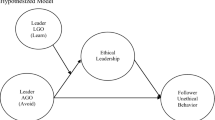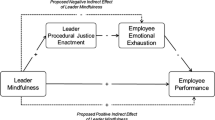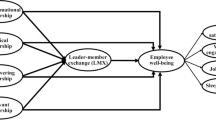Abstract
Although empowering leadership is central to employees, leaders, and organizations, few studies have examined follower behavior and its role in incentivizing leaders to engage in empowering leadership. We use an exploratory, sequential mixed methods approach to explore comprehensively the influence of employee characteristics (i.e., work performance and ethical behavior) and leader-perceived threats on empowering leadership. We conducted two studies—the first entailed in-depth interviews of 24 managers from different industries to identify (i) the primary employee factors that determine empowering leadership and (ii) the types of leader-perceived threats. The five employee factors and three leader-perceived threats identified lay the groundwork for the quantitative research in the second study. We used leader–member exchange theory and social dominance theory in analyzing data from 357 pairs of employee–supervisor questionnaires. The analysis confirmed the importance of employee ethical behavior (versus work performance) in predicting empowering leadership, and the crucial role of leader trust in connecting employee ethical behavior and work performance with empowering leadership. Leader-perceived power threats negatively influence empowering leadership and mitigate the positive impact of leader trust on empowering leadership. Thus, this study extends the literature’s perspective about empowering leadership to include ethical concerns and leader–member interaction.



Similar content being viewed by others
Notes
In this paper, the term leader–member relationship refers to an informal, specific personal connection between leaders and subordinates based on implicit shared commitments, loyalty, and obligation (Miao et al., 2020). The leader–member relationship and LMX are related, but distinct, constructs. Both refer to leader–subordinate relationships and are theoretically grounded in the social exchange theory (Miao et al., 2020). However, LMX is primarily developed using work-related exchange, whereas the leader–member relationship emphasizes personal associations characterized by affective attachment and deference to leadership (Davidson et al., 2017). Considering our research focus and the potential multicollinearity problem (i.e., leader–member relationship is positively related to task performance; Miao et al., 2020), we did not include the leader–member relationship in our quantitative model.
References
Bedi, A., Alpaslan, C. M., & Green, S. (2016). A meta-analytic review of ethical leadership outcomes and moderators. Journal of Business Ethics, 139(3), 517–536.
Blau, P. D. (1964). Exchange and power in social life. Wiley.
Brislin, R. W. (1970). Back-translation for cross-cultural research. Journal of Cross-Cultural Psychology, 1(3), 185–216.
Brower, H. H., Lester, S. W., Korsgaard, M. A., & Dineen, B. R. (2009). A closer look at trust between managers and subordinates: Understanding the effects of both trusting and being trusted on subordinate outcomes. Journal of Management, 35(2), 327–347.
Carpini, J. A., Parker, S. K., & Griffin, M. A. (2017). A look back and a leap forward: A review and synthesis of the individual work performance literature. Academy of Management Annals, 11(2), 825–885.
Cheong, M., Spain, S. M., Yammarino, F. J., & Yun, S. (2016). Two faces of empowering leadership: Enabling and burdening. The Leadership Quarterly, 27(4), 602–616.
Cheong, M., Yammarino, F. J., Dionne, S. D., Spain, S. M., & Tsai, C. (2019). A review of the effectiveness of empowering leadership. The Leadership Quarterly, 30(1), 34–58.
Chow, I. H. (2018). The mechanism underlying the empowering leadership-creativity relationship. Leadership & Organization Development Journal, 39(2), 208–217.
Claydon, T., & Doyle, M. (1996). Trusting me, trusting you? The ethics of employee empowerment. Personnel Review, 25(6), 13–25.
Cohen, J., Cohen, P., West, S. G., & Aiken, L. S. (2003). Applied multiple regression/correlation analysis for the behavioral sciences (3rd ed.). Lawrence Erlbaum Associates.
Colquitt, J. A., Scott, B. A., & LePine, J. A. (2007). A meta-analytic test of their unique relationships with risk taking and job performance. Journal of Applied Psychology, 92(4), 909–927.
Creswell, J. W., & Plano Clark, V. L. (2011). Designing and conducting mixed methods research. Sage.
Davidson, T., Dyne, L. V., & Lin, B. (2017). Too attached to speak up? It depends: How supervisor–subordinate guanxi and perceived job control influence upward constructive voice. Organizational Behavior & Human Decision Processes, 143, 39–53.
De Hoogh, A. H. B., & Den Hartog, D. N. (2009). Ethical leadership: The positive and responsible use of power. In D. Tjsovold & B. Van Knippenberg (Eds.), Power and interdependence in organizations (pp. 338–354). Cambridge: Cambridge University Press.
Dennerlein, T., & Kirkman, B. L. (2022). The hidden dark side of empowering leadership: The moderating role of hindrance stressors in explaining when empowering employees can promote moral disengagement and unethical pro-organizational behavior. Journal of Applied Psychology. https://doi.org/10.1037/ap10001013
Dienesch, R. M., & Liden, R. C. (1986). Leader-member exchange model of leadership: A critique and further development. Academy of Management Review, 11(3), 618–634.
Dirks, K., & Ferrin, D. L. (2002). Trust in leadership: Meta-analytic findings and implications for research and practice. Journal of Applied Psychology, 87(4), 611–628.
Dulebohn, J. H., Bommer, W. H., Liden, R. C., Brouer, R. L., & Ferris, G. R. (2012). A meta-analysis of antecedents and consequences of leader-member exchange: Integrating the past with an eye toward the future. Journal of Management, 38(6), 1715–1759.
Feenstra, S., Jordan, J., Walter, F., & Stoker, J. I. (2020). Antecedents of leaders’ power sharing: The roles of power instability and distrust. Organizational Behavior and Human Decision Processes, 157(4), 115–128.
Ferris, G. R., Arthur, M. M., Berkson, H. M., Kaplan, D. M., Harrell-Cook, G., & Frink, D. D. (1998). Toward a social context theory of the HRM-organization effectiveness relationship. Human Resource Management Review, 8(3), 235–264.
Flick, U. (2002). An introduction to qualitative research (2nd ed.). Sage Publication.
Fornell, C., & Larcker, D. F. (1981). Evaluating structural equation models with unobservable and measurement error. Algebra and Statistics, 18(3), 375–381.
Fraedrich, J. P. (1993). The ethical behavior of retail managers. Journal of Business Ethics, 12(3), 207–218.
Fulmer, A., & Gelfand, M. (2012). At what level (and in whom) we trust: Trust across multiple organizational levels. Journal of Management, 38(4), 1167–1230.
Gong, Y., Huang, J., & Farh, J. L. (2009). Employee learning orientation, transformational leadership, and employee creativity: The mediating role of employee creative self-efficacy. Academy of Management Journal, 52(4), 765–778.
Graen, G. B., Novak, M. A., & Sommerkamp, P. (1982). The effects of leader-member exchange and job design on productivity and satisfaction: Testing a dual attachment model. Organizational Behavior & Human Performance, 30(1), 109–131.
Graen, G. B., & Uhlbien, M. (1995). Relationship-based approach to leadership: Development of leader-member exchange (LMX) theory of leadership over 25 years: Applying a multi-level multi-domain perspective. The Leadership Quarterly, 6(2), 219–247.
Hair, J. F., Black, B., Babin, B., Anderson, R. E., & Tatham, R. L. (2006). Multivariate data analysis (6th ed.). Upper Saddle River.
Hakimi, N., Knippenberg, D. V., & Giessner, S. (2010). Leader empowering behaviour: The leader’s perspective. British Journal of Management, 21(3), 701–716.
Halbusi, A. H., Ruiz-Palomino, P., Morales-Sánchez, R., & Abdel Fattah, F. A. M. (2021). Managerial ethical leadership, ethical climate and employee ethical behavior: Does moral attentiveness matter? Ethics & Behavior. https://doi.org/10.1080/10508422.2021.1937628
Han, S., Harold, C. M., & Cheong, M. (2019). Examining why employee proactive personality influences empowering leadership: The roles of cognition- and affect-based trust. Journal of Occupational and Organizational Psychology, 92(2), 352–383.
Haynes, J. (1895). Risk as an economic factor. The Quarterly Journal of Economics, 9(4), 409–449.
Hoang, G., Wilson-Evered, E., Lockstone-Binney, L., & Luu, T. T. (2021). Empowering leadership in hospitality and tourism management: A systematic literature review. International Journal of Contemporary Hospitality Management, 33(12), 4182–4214.
Hofstede, G. (2001). Culture’s consequences: Comparing values, behaviors, institutions, and organizations across nations (2nd ed.). Sage Publications.
Jackson, E. M., & Johnson, R. E. (2012). When opposites do (and do not) attract: Interplay of leader and follower self-identities and its consequences for leader–member exchange. The Leadership Quarterly, 23(3), 488–501.
Kark, R., Shamir, B., & Chen, G. (2003). The two faces of transformational leadership: Empowerment and dependency. Journal of Applied Psychology, 88(2), 246–255.
Khan, A. K., Moss, S., Quratulain, S., & Hameed, I. (2018). When and how subordinate performance leads to abusive supervision: A social dominance perspective. Journal of Management, 44(7), 2801–2826.
Kifer, Y., Heller, D., Perunovic, W. Q. E., & Galinsky, A. D. (2013). The good life of the powerful the experience of power and authenticity enhances subjective well-being. Psychological Science, 24(3), 280–288.
Kim, J., Shin, Y., & Lee, S. (2017). Built on stone or sand: The stable powerful are unethical, the unstable powerful are not. Journal of Business Ethics, 144(2), 437–447.
Lam, W., Huang, X., & Snape, E. (2007). Feedback-seeking behavior and leader-member exchange: Do supervisor-attributed motives matter? Academy of Management Journal, 50(2), 348–363.
Lee, A., Willis, S., & Tian, A. W. (2018). Empowering leadership: A meta-analytic examination of incremental contribution, mediation, and moderation. Journal of Organizational Behavior, 39(3), 306–325.
Lee, S., Cheong, M., Kim, M., & Yun, S. (2017). Never too much? The curvilinear relationship between empowering leadership and task performance. Group & Organization Management, 42(1), 11–38.
Leheta, D., Dimotakis, N., & Schatten, J. (2017). The view over one’s shoulder: The causes and consequences of leader’s envy of followers. The Leadership Quarterly, 28(3), 451–468.
Liden, R. C., & Maslyn, J. M. (1998). Multidimensionality of leader-member exchange: An empirical assessment through scale development. Journal of Management, 24(1), 43–72.
Lin, M. Z., Ling, Q., Luo, Z. H., & Wu, X. Y. (2019). Why does empowering leadership occur and matter? A multilevel study of Chinese hotels. Tourism Management Perspectives, 32, 1–11.
Lin, M. Z., Ling, Q., Zhang, L. Y., Cui, X. T., & Zhang, Z. J. (2022). The effects of manager role stress on job thriving of both employees and managers through empowering leadership. Tourism Management. https://doi.org/10.1016/j.tourman.2022.104545
Locke, K. (2001). Grounded theory in management research. Sage Publications.
Lu, C. S., & Lin, C. C. (2014). The effects of ethical leadership and ethical climate on employee ethical behavior in the International Port Context. Journal of Business Ethics, 124(2), 209–223.
Macphee, M., Dahinten, V. S., Hejazi, S., Laschinger, H., Kazanjian, A., Mccutcheon, A., Skelton-Green, J., & O’Brien-Pallas, L. (2014). Testing the effects of an empowerment-based leadership development programme: Part 1-leader outcomes. Journal of Nursing Management, 22, 4–15.
Mayer, R. C., Davis, J. H., & Schoorman, F. D. (1995). An integrative model of organizational trust. Academy of Management Review, 20(3), 709–734.
Messick, D. M. (1996). Why ethics is not the only thing that matters. Business Ethics Quarterly, 6(2), 223–226.
Miao, C., Qian, S., Banks, G. C., & Seers, A. (2020). Supervisor-subordinate guanxi: A meta-analytic review and future research agenda. Human Resource Management Review, 30(2), 100702.
Neuendorf, K. A. (2002). The content analysis handbook. Sage.
Neuman, W. L. (2006). Social research methods. Pearson Education.
Oh, I., Harold, C. M., & Lee, J. (2014). Fit happens globally: A meta-analytic comparison of the relationships of person-environment fit dimensions with work attitudes and performance across East Asia, Europe, and North America. Personnel Psychology, 67(1), 99–152.
Ou, A. Y., Tsui, A. S., Kinicki, A. J., Waldman, D. A., Xiao, Z., & Song, L. J. (2014). Humble chief executive officers’ connections to top management team integration and middle managers’ responses. Administrative Science Quarterly, 59(1), 34–72.
Podsakoff, P. M., Mackenzie, S. B., Lee, J. Y., & Podsakoff, N. P. (2003). Common method biases in behavioral research: A critical review of the literature and recommended remedies. Journal of Applied Psychology, 88(5), 879–903.
Pratto, F., Sidanius, J., & Levin, S. (2006). Social dominance theory and the dynamics of intergroup relations: Taking stock and looking forward. European Review of Social Psychology, 17, 271–320.
Preacher, K. J., & Hayes, A. F. (2008). Asymptotic and resampling strategies for assessing and comparing indirect effects in multiple mediator models. Behavior Research Methods, 40(3), 879–891.
Rua, T., Lawter, L., & Andreassi, J. K. (2017). Desire to be ethical or ability to self-control: Which is more crucial for ethical behavior? Business Ethics: A European Review, 26(3), 288–299.
Ryan, G. W., & Bernard, R. H. (2003). Techniques to identify themes. Field. Methods, 15, 85–109.
Sharma, P. N., & Kirkman, B. L. (2015). Leveraging leaders: A literature review and future lines of inquiry for empowering leadership research. Group & Organization Management, 40(2), 193–237.
Sidanius, J., Pratto, F., van Laar, C., & Levin, S. (2004). Social dominance theory: Its agenda and method. Political Psychology, 25, 845–880.
Smallfield, J., Hoobler, J. M., & Kluemper, D. H. (2018). How team helping influences abusive supervision and empowering leadership: The role of team affective tone and performance. Journal of Organizational Behavior, 41(2), 757–781. https://doi.org/10.1002/job.2450
Spreitzer, G. M., & Doneson, D. (2005). Musings on the past and future of employee empowerment. In T. Cummings (Ed.), Handbook of organizational development. Thousand Oaks, CA: Sage.
Spreitzer, G. M., & Mishra, A. K. (1999). Giving up control without losing control. Group and Organization Management, 24, 155–187.
Srivastava, A., Bartol, K. M., & Locke, E. A. (2006). Empowering leadership in management teams: Effects on knowledge sharing, efficacy, and performance. Academy of Management Journal, 49(6), 1239–1251.
Stewardt, G. L., & Brown, K. G. (2009). HRM: Linking strategy to practice. John Wiley & Sons.
Strauss, A. L., & Corbin, A. (1998). Basics of qualitative research: Procedures and techniques for developing grounded theory (2nd ed.). Sage Publications.
Tariq, H., Weng, Q. D., Ilies, R., & Khan, A. K. (2019). Supervisory abuse of high performers: A social comparison perspective. Applied Psychology, 70(1), 280–310.
Wang, H., Wu, C. Y., Zhang, Y., & Chen, C. C. (2008). The dimensionality and measure of empowering leadership behavior in the Chinese organizations. Acta Psychologica Sinica, 40(12), 1297–1305. (in Chinese).
Wilkinson, A. (1998). Empowerment: Theory and practice. Personnel Review, 27(1), 40–56.
Xie, L. S. (2006). The antecedents and consequences of employee psychological empowerment in service firms. Nankai Business Review, 9(4), 16–23.
Yang, Y., Long, L., & Zhou, L. (2010). Risk considerations and empowering behavior: The role of leader-member exchange and centralization. Acta Psychologica Sinica, 42(8), 875–885. (in Chinese).
Yu, L., Duffy, M. K., & Tepper, B. J. (2018). Consequences of downward envy: A model of self-esteem threat, abusive supervision, and supervisory leader self-improvement. Academy of Management Journal, 61(6), 2296–2318.
Zhang, G., Zhong, J., & Ozer, M. (2020). Status threat and ethical leadership: A power-dependence perspective. Journal of Business Ethics, 161(3), 665–685.
Zhang, X., & Bartol, K. M. (2010). Linking empowering leadership and employee creativity: The influence of psychological empowerment, intrinsic motivation, and creative process engagement. Academy of Management Journal, 53(1), 107–128.
Funding
This work was supported by National Natural Science Foundation of China (No: 71972077, 71872156).
Author information
Authors and Affiliations
Corresponding author
Ethics declarations
Conflict of Interest
The authors declare that they have no conflicts of interest.
Ethical Approval
All procedures performed in studies involving human participants were in accordance with the ethical standards of the institutional and/or national research committee, as well as with the 1964 Helsinki Declaration and its later amendments or comparable ethical standards.
Informed Consent
Informed consent was obtained from all individual participants included in this study.
Additional information
Publisher's Note
Springer Nature remains neutral with regard to jurisdictional claims in published maps and institutional affiliations.
Appendices
Appendix 1
See Table
4.
Individual In-Depth Interview Protocols
-
1.
In your company, do middle and first-line managers generally delegate work to their subordinates? Why is that the case?
-
2.
Do you often delegate tasks to subordinates in the workplace? Under what circumstances do you let them make decisions and complete tasks independently? What factors do you mainly consider when making your empowerment decisions? Please give specific examples.
-
3.
Please exemplify the types of employees to whom you prefer to delegate.
-
4.
What risks do you face from empowering subordinates? Please exemplify how you control these risks.
-
5.
Please exemplify how you empower your subordinates in the workplace. You may provide an example of successful or failed empowerment. Please detail when, where, and how such cases occurred.
Rights and permissions
Springer Nature or its licensor holds exclusive rights to this article under a publishing agreement with the author(s) or other rightsholder(s); author self-archiving of the accepted manuscript version of this article is solely governed by the terms of such publishing agreement and applicable law.
About this article
Cite this article
Lin, M., Wu, X. & Li, X. Who are the Empowered Employees: Those with High Work Performance or High Ethical Behavior?. J Bus Ethics 186, 615–631 (2023). https://doi.org/10.1007/s10551-022-05232-9
Received:
Accepted:
Published:
Issue Date:
DOI: https://doi.org/10.1007/s10551-022-05232-9




